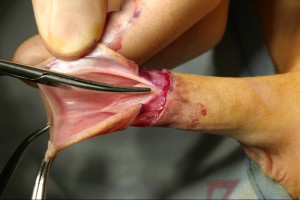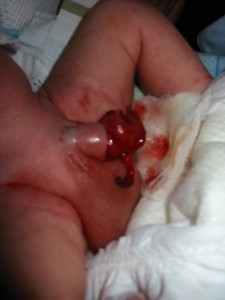WHY?
 Male circumcision is the removal of the foreskin by having it cut off [Latin: circum = around, and cædere = to cut]. It’s impossible to know for certain why this practice originated but there’s documented evidence that it was being carried out as far back as the 23rd century BCE by the ancient Egyptians. “In his 1891 work History of Circumcision, physician Peter Charles Remondino suggests that it began as a less severe form of emasculating a captured enemy as penectomy or castration would likely have been fatal, while some form of circumcision would permanently mark the vanquished yet leave him alive to serve as a slave.” It has also been suggested that over the ages, circumcision has been adopted by various cultures as: a religious sacrifice; as a rite of passage marking a boy’s entrance into adulthood; as a form of sympathetic magic to ensure virility or fertility; as a means of marking those of higher social status; as a means of differentiating a circumcising group from their non-circumcising neighbours; as a means of discouraging masturbation by reducing sexual pleasure or other socially proscribed sexual behaviours; as a means of removing ‘excess’ pleasure; as a means of increasing a man’s attractiveness to women; as a demonstration of one’s ability to endure pain; as a male counterpart to menstruation or the breaking of the hymen; to copy the rare natural occurrence of a missing foreskin of an important leader; a way to repel demonesses; as an aid to hygiene where regular bathing was impractical and as a display of disgust of the smegma produced by the foreskin. It has been suggested that the custom of circumcision gave advantages to tribes that practised it and thus led to its spread.” Whatever the reasoning behind the practice, the removal of the foreskin by circumcision reduces the sensitivity of the penis.
Male circumcision is the removal of the foreskin by having it cut off [Latin: circum = around, and cædere = to cut]. It’s impossible to know for certain why this practice originated but there’s documented evidence that it was being carried out as far back as the 23rd century BCE by the ancient Egyptians. “In his 1891 work History of Circumcision, physician Peter Charles Remondino suggests that it began as a less severe form of emasculating a captured enemy as penectomy or castration would likely have been fatal, while some form of circumcision would permanently mark the vanquished yet leave him alive to serve as a slave.” It has also been suggested that over the ages, circumcision has been adopted by various cultures as: a religious sacrifice; as a rite of passage marking a boy’s entrance into adulthood; as a form of sympathetic magic to ensure virility or fertility; as a means of marking those of higher social status; as a means of differentiating a circumcising group from their non-circumcising neighbours; as a means of discouraging masturbation by reducing sexual pleasure or other socially proscribed sexual behaviours; as a means of removing ‘excess’ pleasure; as a means of increasing a man’s attractiveness to women; as a demonstration of one’s ability to endure pain; as a male counterpart to menstruation or the breaking of the hymen; to copy the rare natural occurrence of a missing foreskin of an important leader; a way to repel demonesses; as an aid to hygiene where regular bathing was impractical and as a display of disgust of the smegma produced by the foreskin. It has been suggested that the custom of circumcision gave advantages to tribes that practised it and thus led to its spread.” Whatever the reasoning behind the practice, the removal of the foreskin by circumcision reduces the sensitivity of the penis.

Circumcised penis on the left and intact penis on the right. The cut penis has no skin to ‘glide’ back and forth whilst the intact penis has all its nerve network which is sensitised when the foreskin slides and glides back and forth
It’s thought that one third of the world’s male population is circumcised, with an estimate of up to 40% of males having undergone the practice. Given that there are around 3.5 billion men on the planet, that means that over one billion of the world’s males have had their foreskins cut off. The impact of circumcision is to disconnect men from their bodies and the pleasure potential of their foreskin. Depending on how the circumcision was carried out, the prospect of Post Traumatic Stress Disorder (PTSD) to those hundreds of million of males that have undergone the procedure would seem to be staggering. In some ways circumcision is analogous to removing the tonsils or the appendix. All of these perform important functions in the body, but have been underappreciated because of society’s general disconnection from the body’s natural functions. The removal of the foreskin has become so deeply entrenched in some cultures and societies that it appears virtually impossible to now stop its practice.
There are numerous devices and contraptions used in conjunction with a scalpel that have been invented to amputate the foreskin quite often with as little skin left over as possible. Depending on the amount of skin cut off, circumcision can deny a man of as much as 80% of his penile skin. Circumcised men usually carry permanent circumcision scars and in extreme cases, as far down as two thirds of their shaft (a very ‘high’ cut) and the obvious tell-tale sign that a significant amount of skin was severed off. It’s been reported by some men with very high cuts that they experience discomfort or pain during erection because the increase in size of the penis stretches the penile skin so tightly as to cause discomfort or pain.
Circumcision desensitizes the penis radically. Foreskin amputation means severing the rich nerve network and all the nerve receptors in the foreskin itself. Circumcision almost always damages or destroys the frenulum. The loss of the protective foreskin desensitizes the glans. Because the membrane covering the permanently externalized glans is now subjected to constant abrasion and irritation, it keratinizes, becoming dry and tough. The nerve endings in the glans, which in the intact penis are just beneath the surface of the mucous membrane, are now buried by successive layers of keratinisation. The denuded glans takes on a dull, greyish, sclerotic appearance. Careful anatomical investigations have shown that circumcision cuts off more than 3 feet of veins and arteries including the frenular artery and branches of the dorsal artery, interrupting normal blood flow to the shaft and glans of the penis, damaging its natural function and altering its development. The loss of 240 feet (73.2m) of nerves, and the copious amounts of specialised nerve endings, means that the most erogenous zone of the male’s body is lost forever. The foreskin’s muscles, glands, mucous membrane, and epithelial tissue are also destroyed as well. More recent research has demonstrated that the clinically important bulbocavernosus reflex is absent in 73% of circumcised men ostensibly due to the removal of fine-touch nerve endings in the ridged band. The long-term effects and the obvious extrapolation is that the more blood flow and nerves you have on your penis, the better sex feels. Thus circumcision is analogous to cutting off the male’s ‘clitoris’ or cutting off the petals of a flower.
Every 2 seconds there’s a male circumcision taking place somewhere in the world. Generally, in most cases where neonates, infants, boys and minors are circumcised, it’s usually done without their consent as they’re unable to do so. The adults responsible or who consent on behalf of the child override the rights of the child to keep one of the most sensitive and sensual parts of their bodies. There are numerous reasons for an adult male to consent to get circumcised. The most necessary being in cases of medical importance, such as malignant growth or penile injury. Some men get cut due to recommendation from doctors because they have a tight foreskin, whilst others get circumcised for cosmetic appearance.
Complications from circumcision
There can be a number of problems resulting in a host of issues for a baby soon after and later on in life from circumcision, including penile adhesions, meatal stenosis (narrowing), meatal ulcer, infection, fistulas, skin bridges, skin tags, too much skin removed, scarring, clamp injuries and deformity to name but a few. More severe complications include haemorrhage, oxygen deprivation, brain damage, galloping gangrene, glans and penile amputations, which in extreme cases has led to gender re-assignment by castration and transgender surgery with the victims expected to live their lives as females. Ultimately and unfortunately in the most extreme of cases, coma and death of the child occurs. Of the 1.25 million new born American males circumcised annually, there are about 230 or so of them who do die as a result of this operation.
Myles Power (YouTube science blogger) discusses the history and science behind circumcision.
Mark D. Reiss, M.D., Executive Vice-President of Doctors Opposing Circumcision discusses the effects of circumcision upon the developing brain and the risks and complications of infant circumcision.










